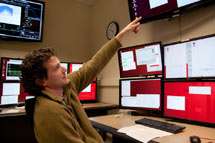Ultra-high Speed Plus Fine-tuned Light Equals a Whole New Look at Materials

(PhysOrg.com) -- X-ray science is getting a boost from a marriage of technologies. Scientists already had instruments that can separate colors of light, but don't pulse fast. And they have fast-pulsing lasers that can't pick more than one color.
Enter the Soft X-Ray Materials Science instrument, or SXR, six weeks away from opening its hutch to experimenters. It can do both at once.
By combining the ultra-fast laser pulses from the Linac Coherent Light Source with a monochromator, which selects wavelengths from a large range of energy, scientists will soon have a tool to probe ultra-fast processes such as electrons shuffling in superconductors, and the magnetic machinations that enable computers to store data.
"It's really exciting," said instrument scientist Josh Turner. "We're the first instrument that can study materials using X-ray lasers that are tunable, pretty much by turning a knob."
Soft X-rays are lower frequency, and hence lower energy, than their "hard" X-ray cousins. Unlike hard X-rays—the kind airport security uses to check inside luggage—soft X-rays barely penetrate matter at all. That makes them well suited to study the surfaces of materials, which harder X-rays would bypass altogether. Because the soft X-ray band is where common elements like carbon and oxygen have atomic resonances, it's the best form of light to probe many common materials.
The instrument, the second along the LCLS, will use ultra-fast laser pulses to delve into the chemical action of molecules. Because the LCLS flashes last for only femtoseconds, about the amount of time it takes light to travel a tenth of a micrometer, the SXR instrument can watch chemical molecules break bonds and change their electron structures.
SXR is uniquely poised to examine these extremely fast events due to its ability to split light into different colors, and hence different energies. In a device called a monochromator, X-ray light from the LCLS beam bounces off a mirror in SXR and onto a diffraction grating. The grating acts like a prism to separate the light into colors and select a tiny range. The light, now representing a narrow band of energy, is then refocused and enters the SXR's experimental chamber. Scientists in the nearby control room can rotate the grating ever so slightly to change the selected color.
While synchrotrons have also used monochromators to split up light, no light source has been as bright as the LCLS or had the ability to pulse as fast. That makes it well-suited for watching chemical reactions, like water splitting into hydrogen and oxygen for fuel cells, or extracting ammonia from nitrogen to produce fertilizers, applications users like SLAC physicist Hirohito Ogasawara are excited about.
"We want to see the electron structure of these molecules, how reactions happen, and how energy is transferred," said Ogasawara. His group brought its own equipment, a device that exposes a sample with SXR's beam and records the photons that are emitted. He's hoping to see how catalysts, molecules that give reactions a kick-start, trade energy between players in a reaction.
With only six weeks before the Soft X-Ray instrument's first scientific users arrive, SLAC scientists are conducting a number of tests to ensure that the instrument works at its best.
The device has already been calibrated, which means it correctly selects energy ranges, and scientists are working to remove vibrations from the other instruments so it can reach its maximum resolving power.
The first SXR experiment will study how state-of-the-art computer storage devices work. In everyday computers, data is committed to memory in about a nanosecond, and new laser devices are aiming to write 1000 times faster. But scientists aren't sure exactly how thin pieces of metal rapidly demagnetize to store data.
"Still, no one understands what's happening," said Hermann Durr, a SLAC physicist who has shined optical X-ray light on these new storage devices. He's been planning to use the SXR ever since it was announced in 2007, he said. "Everyone is expecting a revolution."
Provided by SLAC National Accelerator Laboratory



















